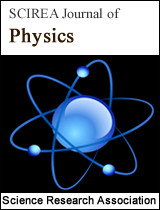New dielectric constant, due to the impurity size effect, and determined by an effective Bohr model, affecting strongly the Mott criterion in the metal-insulator transition and the optical band gap in degenerate (Si, GaAs, InP)-semiconductors
DOI: 10.54647/physics14498 88 Downloads 13912 Views
Author(s)
Abstract
In the n(p)-type degenerate semiconductors, our expression for the relative static dielectric constant, \varepsilon\left(r_{d\left(a\right)}\right), is determined by an effective Bohr model, r_{d\left(a\right)} being the donor (acceptor) d(a)-radius, suggesting that, for an increasing r_{d\left(a\right)}, both \varepsilon\left(r_{d\left(a\right)}\right) and the effective Bohr radius a_B\left(r_{d\left(a\right)}\right), due to such the impurity size effect, decrease (\searrow), according to the increase (\nearrow) in: (i)the effective d(a)-ionization energy E_{d(a)}\left(r_{d\left(a\right)}\right) in absolutes values, (ii) the effective band gap E_{gn(gp)}\left(r_{d\left(a\right)}\right), and also (iii) the critical density N_{CDn(CDp)}\left(r_{d(a)},\ \ 0.25\ley\le1\right) in the MIT, as those showed in Tables 2-4, for the n(p)-type (Si, GaAs, InP)-semiconductors, in which the empirical parameter y has been chosen as: y=0.25 and 0.271. One notes here that y=0.25 was given in the Mott criterion: a_B\timesN_{CD}^{1/3}\approxy=0.25. Further, if denoting the d(a)-density by N, the physical condition given for such degenerate semiconductors (or for the metallic phase) is found to be given by: N\geqN_{CDn(CDp)}. Then, in such the important physical condition, our numerical results of optical band gap (OBG), due to the effects of impurity size and heavy doping, are also investigated and given in Tables 6-8.In summary, our new expression for \varepsilon\left(r_{d\left(a\right)}\right), due to such an impurity size effect, strongly affects a_B\left(r_{d\left(a\right)}\right), N_{CDn(CDp)}\left(r_{d(a)},\ \ \ y\right), and the OBG, obtained in the n(p)-type (Si, GaAs, InP)- degenerate semiconductors.
Keywords
Keywords: effects of impurity size and heavy doping; degenerate semiconductors; static dielectric constant; critical density in metal-insulator transition; optical band gap
Cite this paper
H. Van Cong,
New dielectric constant, due to the impurity size effect, and determined by an effective Bohr model, affecting strongly the Mott criterion in the metal-insulator transition and the optical band gap in degenerate (Si, GaAs, InP)-semiconductors
, SCIREA Journal of Physics.
Volume 7, Issue 5, October 2022 | PP. 221-234.
10.54647/physics14498
References
| [ 1 ] | N. F. Mott, “Metal-Insulator Transitions,” London: Taylor and Francis, 1974. |
| [ 2 ] | A. Pergament, “Metal-insulator transition: the Mott criterion and coherence length,” J. Phys.: Condense Matter, vol. 15, pp. 3217-3223, 2003. |
| [ 3 ] | P. P. Edwards et al., “The metal-insulator transition: a perspective,” Phil. Trans. R. Soc. London A , vol. 356, pp. 5-22, 1998. |
| [ 4 ] | C. Kittel, “Introduction to Solid State Physics, pp. 84-100. Wiley, New York (1976). |
| [ 5 ] | H. Van Cong et al., “Size effect on different impurity levels in semiconductors,” Solid State Communications, vol. 49, pp. 697-699, 1984; H. Van Cong, “Effects of impurity size and heavy doping on energy-band-structure parameters of various impurity-Si systems,” Physica B, vol. 487, pp. 90-101, 2016. |
| [ 6 ] | H. Van Cong, and G. Debiais, “A simple accurate expression of the reduced Fermi energy for any reduced carrier density. J. Appl. Phys., vol. 73, pp. 1545-15463, 1993. |
| [ 7 ] | H. Van Cong, “Effects of donor size and heavy doping on optical, electrical and thermoelectric properties of various degenerate donor-silicon systems at low temperatures,” American Journal of Modern Physics, vol. 7, pp. 136-165, 2018; H. Van Cong et al., “28.68% (29.87%)- Limiting Highest Efficiencies obtained in Crystalline Silicon Junction Solar Cells at 300K, Due to the Effects of Heavy (Low) Doping and Impurity Size, “SCIREA J. Phys., vol.7, pp. 160-179, 2022; H. Van Cong et al., “30.76% (42.73%)- Limiting Highest Efficiencies obtained in Crystalline GaAs Junction Solar Cells at 300K, Due to the Effects of Heavy (Low) Doping and Impurity Size, “SCIREA J. Phys., vo.7, pp. 180-199, 2022. |
| [ 8 ] | M. A. Green, “Intrinsic concentration, effective density of states, and effective mass in silicon,” J. Appl. Phys., vol. 67, 2944-2954, 1990. |
| [ 9 ] | J. Wagner and J. A. del Alamo, J. Appl. Phys., vol. 63, 425-429, 1988. |

